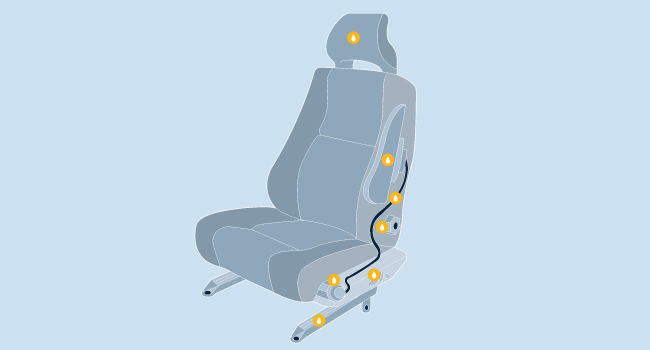Seating Components
Lubricating seat tracks is an aesthetic and mechanical challenge. When seats are pushed completely forward or back, a portion of the tracks is exposed, so neutral colored greases are preferred. Because of the track’s proximity to seat fabric and carpeting, the grease cannot stain or leak oil. Finally, the seat track assembly has to allow for play without rattling or vibrating at high speeds. Nye offers lubricants for seat tracks, control cables, lumbar actuators, position motors, reclining mechanisms, headrest posts, and power seat switches to deliver a “quality” feel for seat adjustment.

Both the driver and passenger seat contain lumbar support systems that adjust to desired comfort levels. Lubricating the gears in the lumbar actuator will reduce noise and friction.
Lumbar Actuator - Rheolube® 365F
With as many as three motors underneath the seat, a transmission should exhibit efficient power-transfer capability, yet never leak, drip, or stain. A PTFE-fortified, synthetic hydrocarbon grease is a proven formula and is recommended for gears inside the seat transmission housing.
Seat Motor Gearbox - Rheolube® 363F
Adjusting the angles and position of a seat requires a switch to actuate the seat motors. These sliding contact switches require a lubricant that exhibits wear protection, corrosion resistance, and good plastic compatibility.
Switch - Rheolube® 362F
Lubricating seat tracks is an aesthetic and mechanical challenge. When seats are pushed completely forward or back, a portion of the tracks is exposed, so neutral colored greases are preferred. Because of the track’s proximity to seat fabric and carpeting, the grease cannot stain or leak oil. Finally, the seat track assembly has to allow for play without rattling or vibrating at high speeds.
Seat recliner mechanisms must be able to move forward and backward with a smooth, controlled motion. A properly selected lubricant that stays in place will ensure a quality feel of operation when passengers either manually or automatically adjust the angle of the back, while also reducing noise generated by vibration and friction from the reclining mechanisms.
Recliner Mechanism - Uniflor™ 8172
Control cables actuate many seat movements and can be under high loads and constant cycling. A lubricant will improve cable efficiency by reducing friction, allowing the cable to move under a broad range of operating conditions in a quick, smooth manner.
Control Cable - Fluorocarbon Gel 990A
The headrest sliding parts stay at rest for long periods - a difficult duty for grease, which tends to get squeezed out of the surfaces that are in contact. Additionally, due to the headrest location, lubricants cannot leak oil or emit odor. A lubricant enables the headrest to remain in place for extended periods yet move smoothly when activated.
Headrest Pivot - Uniflor™ 8472
Headrest Post - Uniflor™ 8470
Lubricants for Automotive Seating Components
| Product | Chemistry (Base Oil / Thickener) | Temp Range | Product Description | Application Notes |
|---|---|---|---|---|
| FLUOROCARBON GEL 990A | Dimethyl Silicone/PTFE | -40 to 200°C | A heavy viscosity grease. Benefits include EP and rust inhibiting additives. | Control Cable |
|
RHEOLUBE 362F |
PAO/Lithium Soap | -54 to 125°C | A light viscosity grease. Excellent low temperature performance | Power Seat Switch |
|
RHEOLUBE 363F |
PAO/Lithium Soap | -50 to 125°C | A medium viscosity grease. Benefits include increased friction reduction. | Seat Motor Gearbox |
|
RHEOLUBE 365F |
PAO/Lithium Soap | -45 to 125°C | A medium viscosity grease. Benefits include reduced friction and reduced start-up torque. | Lumbar Actuator |
|
UNIFLOR 8172 |
PFPE/PTFE | -45 to 225°C | A light viscosity grease. Benefits include excellent plastic and elastomer compatibility and resistance to aggressive chemicals. | Recliner Mechanism |
|
UNIFLOR 8472 |
PFPE/PTFE | -50 to 225°C | A medium viscosity base oil. Benefits include excellent oxidation resistance, material compatibility, and aggressive chemical inertness. | Headrest Pivot |
|
UNIFLOR 8470 |
PFPE | -50 to 225°C | A medium viscosity oil. Benefits include excellent oxidation resistance, plastic and elastomer compatibility and aggressive chemical inertness. | Headrest Post |

